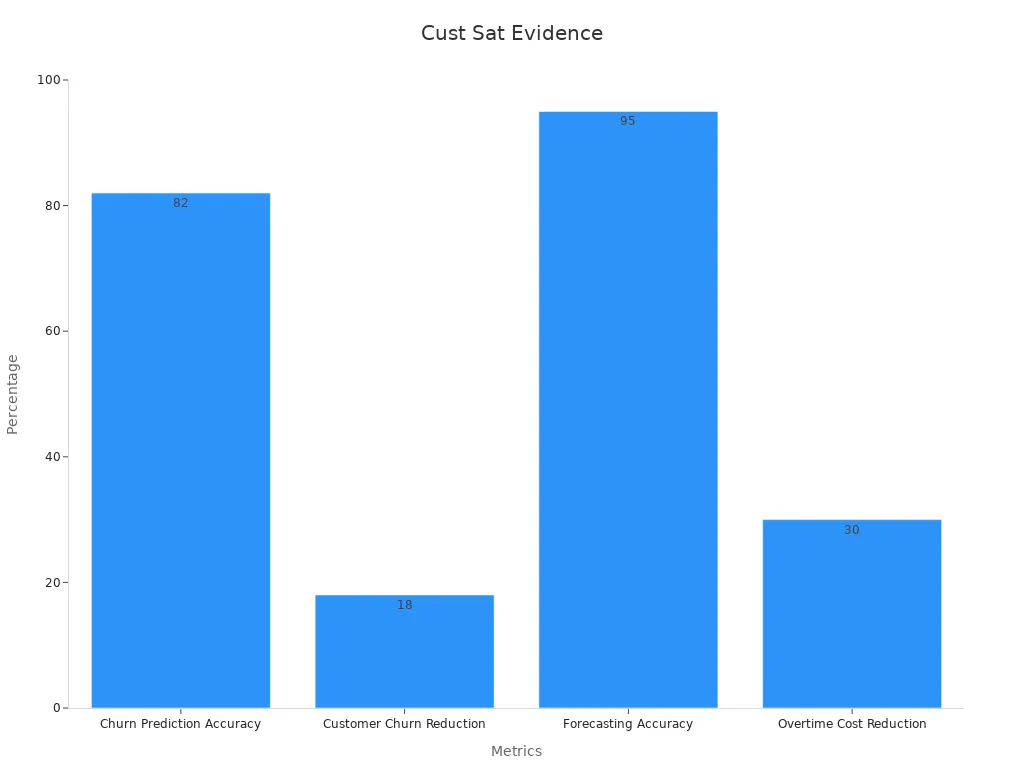How AI and Machine Learning Drive Call Center Sentiment Analysis

AI and machine learning have changed call center sentiment analysis, making it possible to understand customer emotions with greater accuracy. Today, AI tools analyze every customer call, not just a sample, so teams can detect frustration or satisfaction faster. This helps agents deliver better service and improve the customer experience. Sobot stands out by using AI-powered solutions that monitor tone, pitch, and word choice during calls. With Sobot AI, businesses can capture real-time insights and support millions of customers worldwide. These advances help companies meet customer needs, provide excellent service, and create a better experience for everyone.
AI in Call Center Sentiment Analysis

How AI Detects Customer Emotions
AI analyses voice calls by examining both what customers say and how they say it. Voice call sentiment analysis uses advanced models to pick up on emotional cues in speech, such as tone, pitch, and word choice. Researchers have shown that deep learning and transformer-based models, like BERT and RoBERTa, can capture complex emotional patterns in conversations. These models outperform older methods and help call centers understand customer sentiment more accurately.
A study tested emotion classification systems using real voice and text samples from contact centers. Psychologists and engineers identified emotional signals, such as changes in pitch or intensity, to detect feelings like anger, happiness, or sadness. Machine learning models, including CNN and SVM, learned to recognize these signals. The results showed that voice call sentiment analysis tools could classify emotions with accuracy rates from 60% to over 80%. This level of analysis helps contact center operations match callers with the right agents and improve virtual assistants.

Sobot’s Voice/Call Center product uses AI-powered voicebots to analyze every call. The system listens for emotional signals and provides real-time insights to agents and managers. This approach helps teams respond quickly to customer needs and improves overall service quality.
Note: Voice call sentiment analysis tools can also help supervisors monitor agent performance and identify coachable moments.
Real-Time and Post-Call Insights
Real-time sentiment analysis gives contact center teams instant feedback during calls. AI analyses voice calls as they happen, updating dashboards with sentiment scores and emotional trends. Managers can see if a customer feels frustrated or satisfied and step in to support agents when needed. This process helps teams move from reactive to proactive support.
After each call, sentiment analysis tools review the conversation again. They provide detailed insights into customer sentiment, agent performance, and call outcomes. These post-call insights help managers spot patterns, such as frequent issues or common emotional triggers. Teams can use this information to improve training, update scripts, and make better decisions.
Sobot’s Voice/Call Center solution offers both real-time and post-call sentiment analysis. The platform tracks key metrics, highlights emotional cues, and delivers actionable insights. This helps businesses improve customer satisfaction and make data-driven decisions.
Studies show that integrating AI and machine learning into call center sentiment analysis leads to higher customer loyalty and better operational effectiveness. Neural network-based models provide the highest accuracy for voice call sentiment analysis, making them essential tools for modern contact center operations.
What Is Sentiment Analysis?
Definition and Purpose
Sentiment analysis is an automated process that detects if a message or conversation is positive, negative, or neutral. This analysis helps companies understand how customers feel about their products, services, or brand. Businesses use sentiment analysis to study customer feedback from sources like surveys, reviews, social media, and support tickets. By using techniques such as aspect-based sentiment analysis, intent analysis, and emotion detection, companies can categorize and understand feedback more deeply.
For example, a television manufacturer once used sentiment analysis to review customer comments. The company learned which features customers liked and which ones caused problems. This allowed the business to improve its products and marketing strategies. Many companies now rely on sentiment analysis to guide service improvements, encourage feedback, and assure brand quality. Hybrid sentiment analysis systems can reach up to 91% accuracy, making them highly reliable for customer service environments. Multi-channel analysis uncovers nearly three times more actionable insights than single-channel methods. Companies like Microsoft and Adobe have seen customer satisfaction improve by up to 26% after using these tools.
Sentiment analysis gives businesses a clear view of customer emotions, opinions, and intentions, helping them make better decisions.
Why It Matters for Customer Service
Sentiment analysis plays a key role in customer service. It helps teams spot unhappy customers quickly and respond before issues grow. Negative sentiment often signals problems that need fast attention. Companies use sentiment analysis tools to prioritize messages, reduce support backlogs, and shorten wait times.
- Happy customers spend up to 140% more, showing the value of positive sentiment.
- Tailored experiences based on sentiment insights boost loyalty by 1.5 times.
- 60% of customers leave brands after bad experiences, so monitoring sentiment is vital for retention.
- Real-time sentiment analysis can make escalation management up to 40% faster and improve customer retention by 25%.
- Customer satisfaction scores can rise by 15-20% after using sentiment analysis tools.
Sobot’s Voice/Call Center solution uses AI-powered sentiment analysis to help businesses monitor calls, detect emotions, and improve service quality. By analyzing every interaction, Sobot enables companies to resolve issues faster and deliver better customer experiences. Companies like James Villas and Glammmup have seen resolution times drop and satisfaction scores rise after adopting sentiment analysis tools (source).
Core Technologies: AI, NLP, and Machine Learning
Natural Language Processing in Voice Calls
Sobot uses natural language processing to help its Voice/Call Center solution understand what customers say and how they feel. This technology listens to live calls and picks up on words, tone, and even pauses. Voice call sentiment analysis works by tagging emotions in real time. For example, if a customer says, “I want to cancel,” the system flags this as negative sentiment. The AI can also notice when a customer sounds happy or upset by listening to their pace and inflection.
Many sentiment analysis tools use NLP to support agents during calls. These tools can suggest scripts or alert managers if a call gets tense. Platforms like IBM Watson and Microsoft Azure show that NLP can work in many languages and help businesses adjust their service for different customers. Sobot’s system uses these advanced methods to make sure every call gets the right attention. This approach helps agents respond quickly and keeps customers satisfied.
Tip: Real-time voice call sentiment analysis can reduce handling time and prevent mistakes by giving agents instant feedback.
Machine Learning Models for Sentiment
Machine learning algorithms play a big role in voice call sentiment analysis. These models learn from thousands of past calls to spot patterns in speech and text. Sobot’s AI tools for sentiment analysis use deep learning networks trained on large datasets. These networks can detect emotions like frustration, excitement, or satisfaction, even if the call has background noise or different accents.
Studies show that models like SVM, LSTM, and neural networks can reach high accuracy in sentiment analysis. For example, SVM achieved up to 93% accuracy in classifying YouTube review sentiments. In financial services, LSTM models improved prediction results for customer mood. The table below shows how different machine learning models perform in various sentiment analysis tasks:
| Application Area | Models Used | Accuracy/Results |
|---|---|---|
| Smartphone Brand Sentiment Analysis | SVM, MLP, Naive Bayes | Positive trends by brand, high accuracy |
| YouTube Review Sentiment Classification | Decision Tree, kNN, SVM | SVM: 93% accuracy |
| Financial Asset Sentiment Analysis | RNN, LSTM | Improved prediction accuracy |
Sobot’s voice call sentiment analysis combines these machine learning algorithms with generative AI for sentiment analysis. This allows the system to predict customer needs and suggest next steps. Predictive analytics can even warn managers about customers at risk of leaving. By using call center text analytics, Sobot helps businesses make better decisions and improve service quality.
Note: Generative AI for sentiment analysis can create new ways to understand customer emotions and improve agent coaching.
Voice Call Sentiment Analysis Applications

Real-Time Monitoring
Voice call sentiment analysis gives call centers the power to monitor conversations as they happen. AI tools transcribe every word and analyze the emotional tone in real time. This process helps teams spot customer frustration or happiness right away. Supervisors can see live dashboards with sentiment scores and trends, allowing them to step in when needed. Real-time monitoring reduces the need for manual reviews and helps agents stay on track. Sobot’s Voice/Call Center solution uses proprietary AI trained on millions of business calls, ensuring accurate transcription and immediate insights. By combining data from calls, CRM, and surveys, teams get a complete view of customer emotions and can act quickly to improve satisfaction.
Real-time sentiment analysis reduces agent burnout by providing live coaching cues during heated calls, improving both agent well-being and customer experience.
Agent Support and Coaching
Voice call sentiment analysis transforms agent support from a reactive process to a proactive one. AI-powered tools provide instant feedback on agent performance during live calls. These insights help agents adjust their approach and resolve customer issues more effectively. Automated feedback highlights areas for improvement, such as tone or script adherence. Sobot’s platform delivers AI-generated summaries and performance analysis, making it easy for managers to identify coaching opportunities. This approach supports evidence-based coaching and helps agents focus on urgent customer needs. Companies using sentiment analysis report higher agent satisfaction and better customer outcomes.
- Sentiment analysis converts conversations into data, tracking metrics like call handling time and resolution rates.
- Real-time insights allow agents to improve performance immediately.
Actionable Insights for Managers
Managers rely on actionable insights from voice call sentiment analysis to drive performance and strategy. AI organizes calls by sentiment, urgency, and topic, making it easy to spot trends and recurring issues. Combining sentiment data with operational metrics creates powerful reports that benchmark performance over time. Sobot’s analytics dashboard helps managers identify friction points, segment customer data, and compare team results. These insights support targeted training, smarter staffing, and proactive interventions. By tracking sentiment alongside key performance indicators, managers can validate which strategies improve customer satisfaction and business outcomes.
Industry data shows 80% of organizations now use AI to boost agent productivity and customer experience (Salesforce Research).
Benefits of Call Center Sentiment Analysis
Customer Satisfaction
Sentiment analysis helps companies measure customer satisfaction directly from real conversations. Instead of relying only on surveys, businesses can use insights from every call or message. This approach captures the true voice of the customer and uncovers emotions that might not appear in written feedback. For example, Once Again, a French online retailer, improved its email conversion rate by about 40% after using sentiment analysis to boost customer satisfaction. Companies see improvements in key metrics like CSAT, NPS, and FCR when they use these insights to guide agent training and service changes. Sobot’s Voice/Call Center solution uses AI to analyze calls and provide real-time feedback, helping teams improve customer experience and satisfaction.
| Metric / Outcome | Statistic / Result | Explanation |
|---|---|---|
| Churn Prediction Accuracy | 82% | Sentiment analysis combined with CRM data enabled accurate identification of at-risk customers. |
| Customer Churn Reduction | 18% | Proactive outreach based on sentiment-driven churn scores lowered customer cancellations. |
| Service Level Improvement | From 65% to 90% | Better staffing led to faster call answering, enhancing customer experience. |

Proactive Issue Resolution
Sentiment analysis enables companies to spot problems before they grow. Real-time monitoring detects negative feedback and alerts supervisors to step in quickly. For instance, a telecom company noticed a rise in negative sentiment about dropped calls and fixed network issues before customers left. In hospitality, identifying words like “expensive” or “did not call back” led to better service and a 6% increase in customers the next quarter. Sobot’s AI-powered tools flag unsatisfied customers during calls, allowing agents to resolve issues on the spot. This proactive approach protects customer satisfaction and keeps service quality high.
Data-Driven Decisions
Companies use insights from sentiment analysis to make smarter decisions. By tracking feedback and emotional trends, managers can adjust scripts, improve training, and optimize staffing. Data-driven strategies help pinpoint what makes customers happy or frustrated. Many businesses, like Indeed, use targeted surveys and analytics to guide improvements and resource allocation. The 2024 Data and AI Leadership Executive Survey shows that most companies now invest in analytics to drive innovation and improve customer experience. Sobot’s analytics dashboard gives managers the insights they need to enhance service, boost satisfaction, and improve customer experience across every channel.
Sobot Success Story: Agilent
Efficiency Gains
Agilent, a leader in life sciences and diagnostics, faced a challenge with high volumes of customer inquiries. The company needed a way to handle requests quickly and accurately. After choosing Sobot’s omnichannel workbench and AI-powered chatbot, Agilent saw a dramatic change. The new system allowed the team to manage customer questions across multiple channels without switching platforms. Sobot’s intelligent routing sent each customer to the right agent or automated assistant. This approach reduced wait times and improved response speed.
The results were clear. Agilent reported a sixfold increase in customer service efficiency after using Sobot’s solutions. The AI-powered chatbot handled routine questions, freeing human agents to focus on complex issues. This shift meant that customers received answers faster and with fewer errors. The unified workspace also helped agents see all customer information in one place, making every interaction smoother. Agilent’s team could now support more customers each day, improving overall productivity.
Sobot’s technology helped Agilent transform its customer service operations, making them faster and more reliable.
Customer Satisfaction Results
Better efficiency led to a better customer experience for Agilent. Customers no longer waited long for help. The AI chatbot provided instant answers to common questions, while skilled agents handled special requests. This balance improved the quality of every customer interaction. Agilent’s support team could focus on solving real problems, which made customers feel valued.
Although the case study focused on efficiency, the improvements in speed and accuracy had a direct impact on customer satisfaction. Customers enjoyed faster service and clearer communication. The seamless integration of Sobot’s tools meant that every customer received consistent support, no matter the channel. Agilent’s story shows how advanced technology can raise both efficiency and customer satisfaction in a busy service environment.
AI and machine learning now help call centers understand customer emotions faster and more accurately. Sobot’s solutions use ai to analyze millions of calls each day, leading to a 95% customer satisfaction score for companies like Agilent. Teams see better agent performance and smarter business decisions with these tools. Companies that use ai in their contact centers often report higher loyalty and lower costs (source). Sobot offers a trusted way to improve service and results.
FAQ
What is call center sentiment analysis?
Call center sentiment analysis uses AI and machine learning to detect emotions in customer calls. Sobot’s Voice/Call Center solution analyzes tone, words, and pitch. This helps teams understand if customers feel happy, upset, or neutral. Accurate sentiment analysis improves service and customer satisfaction.
How does AI improve call center sentiment analysis?
AI processes every call in real time. It identifies emotional cues and provides instant feedback to agents. Sobot’s AI-powered Voice/Call Center uses advanced models to spot frustration or satisfaction. This leads to faster responses and better customer experiences. Studies show AI can boost customer loyalty by 25% (source).
Why is machine learning important for sentiment analysis?
Machine learning models learn from thousands of calls. They recognize patterns in speech and text. Sobot’s Voice/Call Center uses these models to detect emotions, even with background noise. This technology helps companies make data-driven decisions and improve call center sentiment analysis accuracy.
Can Sobot’s Voice/Call Center analyze calls in multiple languages?
Yes. Sobot’s Voice/Call Center supports multi-language sentiment analysis. The system uses AI and machine learning to understand emotions in different languages. This feature helps global businesses deliver consistent service and accurate call center sentiment analysis worldwide.
What benefits do managers get from call center sentiment analysis?
Managers use call center sentiment analysis to track trends, spot issues, and improve agent training. Sobot’s analytics dashboard provides real-time insights and performance reports. This data helps managers make smart decisions, increase efficiency, and raise customer satisfaction scores.
See Also
Comprehensive Overview Of AI Software For Call Centers
Evaluating Artificial Intelligence Solutions For Enterprise Call Centers
Best Ten AI Technologies For Enterprise Contact Centers
